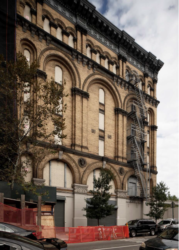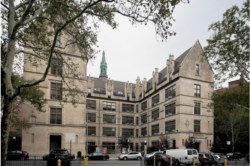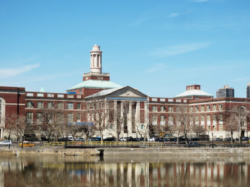
Webber Packing House. Image Credit: LPC.
Potential individual landmarks added to the Commission’s calendar include two schools and a former meat packing plant. On November 14, 2017, Landmarks voted to add three items in East Harlem to its calendar for consideration as individual City landmarks. The three buildings are: The Richard Webber Harlem Parking House, at 207 East 109th Street; the former Public School 109, at 215 East 99th Street; and the former Benjamin Franklin High School, at 260 Pleasant Avenue. The identification of the properties were done through a survey undertaken as part of a comprehensive plan to bring affordable housing and other public benefits to East Harlem.
The three buildings were identified by Landmarks in a survey undertaken in the neighborhood, in partnership with City Planning in advance of the East Harlem Rezoning. As part of the survey, Commission staff also identified cultural historic resources for possible inclusion on the National Register. The actions by City Planning and Landmarks are being undertaken in response to the comprehensive East Harlem Neighborhood Plan, crafted with input from a variety of local stakeholders. Landmarks’ Lisa Kersavage noted that the area possessed 13 existing individual landmarks.
Before discussing the individual buildings, Research Department staff presented an overview of the development and demographic history of the neighborhood. The neighbor that came to be named East Harlem was rural and sparsely populated until the mid-19th century. The area became accessible by rail in the 1830, and attracted its first significant residential development, primarily for Irish and German immigrants. The neighborhood grew rapidly in the 1850s and 60s as transportation options and manufacturing work along the East River increased. Speculatively built tenements housed immigrants from Italy and Central Europe, alongside the previously settled ethnic groups. Separate, relatively homogenous, Italian and Jewish enclaves established themselves within the area, while the southern portion of the neighborhood became more culturally mixed.
Puerto Ricans arrived in the neighborhood following the passage of the Jones Act in 1917, eventually displacing the Jewish community. The Puerto Rican community grew enormously following the Second World War, earning the neighborhood its “Spanish Harlem” moniker. The area was heavily affected by “slum clearance” initiatives in the 1960s that reorganized the street grid and saw the construction of large public housing projects.
The six-story Romanesque Revival Richard Webber Harlem Packing House dates to 1895, and was part of an inclusive slaughtering, meatpacking and retail complex, of which it is the sole remaining structure. It was built for Richard Webber, an English immigrant who started a small butcher shop in the 1870s, and ultimately employed 500 people as one of the largest figures in the City’s meat trade.
Bartholomew and John Peter Walther designed the building. The father-and-son architects were responsible for numerous factories, warehouses, and flats in upper Manhattan. The Packing House has a stone base with a tripartite facade composed largely of brick. Arches and pilasters with Corinthian capitals are topped by a prominent bracketed cornice. Decorative terra cotta cow heads reflect the building’s original function.

PS 109. Image Credit LPC.
The former Public School 109 was completed in 1901 to designs by C.B.J. Snyder. Snyder, a prominent innovator in school design, served as Superintendent of School Buildings from 1891 to 1923. P.S. 109 exemplifies one of Snyder’s most significant innovations, the “H-plan,” that allowed light and air into classrooms and created space for recreation. Other landmarked works by Snyder include Stuyvesant High School, Public School 166, Flushing High School, and Curtis High School, among others.
The Collegiate Gothic P.S. 109 is clad in limestone and brick, and decorated with terra cotta gargoyles and arches. At the time of its construction, P.S. 109 served a population of European immigrants. The five-story building could accommodate more than 2,000 students.
The school closed in 1996, due largely to deteriorated conditions. The building has been restored, and now serves the community as El Barrio’s Artspace PS109, providing space for a gallery, cultural organizations, and live-work opportunities for artists.
The Georgian Revival Benjamin Franklin High School, designed by Eric Kebbon, stands on the Harlem River. Kebbon was Board of Education’s head architect of school construction. The Georgian revival architecture was intended to reflect democratic ideals. The building is faced in brick and limestone, with symmetrical facades.

Benjamin Franklin High School. Image Credit LPC.
The school was the second Benjamin Franklin High School and the first high school in East Harlem. Benjamin Franklin High School was the brainchild of educator, activist and urban sociologist Leonard Covello. Covello, an Italian immigrant and East Harlem resident, envisioned a school that would serve the Italian immigrant population through bilingual education and community engagement. As a teacher, he created the first Italian-language class in the country, and as principal, he believed in a link between education and social activism, theories informed by the Settlement House Movement that he first implemented at Benjamin Franklin. Students attended school in their own community, where he invited parents and community members to participate in the school, and also held events in the community.
Originally focused on Italian immigrants and their community, Covello adapted his methods to meet the needs of children and residents from Puerto Rico. Outreach and orientation was conducted in Spanish, and the school formed a Puerto Rican cultural club.
Landmarks Research Department argued that the building was a prominent part of the neighborhood’s built environment, and well as an important component of East Harlem’s social history. The building still functions as a school, and currently houses the Manhattan School of Science and Math, and Isaac Newton Middle School for Math and Science.
Commissioners voted unanimously to add all three buildings to its calendar. No date for hearings on designation have been established.
LPC: Richard Webber Harlem Packing House, 207 E. 119th Street, Manhattan (LP-2595); Public School 109, 215 East 99th Street, Manhattan (LP-2597); Benjamin Franklin High School, 260 Pleasant Avenue, Manhattan (LP-2596) (Nov. 14, 2017).
By: Jesse Denno (Jesse is a full-time staff writer at the Center for NYC Law).

